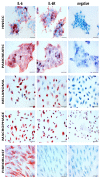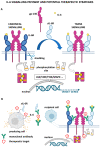The Role of IL-6 in Cancer Cell Invasiveness and Metastasis-Overview and Therapeutic Opportunities
- PMID: 36429126
- PMCID: PMC9688109
- DOI: 10.3390/cells11223698
The Role of IL-6 in Cancer Cell Invasiveness and Metastasis-Overview and Therapeutic Opportunities
Abstract
Interleukin 6 (IL-6) belongs to a broad class of cytokines involved in the regulation of various homeostatic and pathological processes. These activities range from regulating embryonic development, wound healing and ageing, inflammation, and immunity, including COVID-19. In this review, we summarise the role of IL-6 signalling pathways in cancer biology, with particular emphasis on cancer cell invasiveness and metastasis formation. Targeting principal components of IL-6 signalling (e.g., IL-6Rs, gp130, STAT3, NF-κB) is an intensively studied approach in preclinical cancer research. It is of significant translational potential; numerous studies strongly imply the remarkable potential of IL-6 signalling inhibitors, especially in metastasis suppression.
Keywords: IL-6; cancer; metastasis.
Conflict of interest statement
The authors declare no conflict of interest.
Figures






References
-
- Gál P., Brábek J., Holub M., Jakubek M., Šedo A., Lacina L., Strnadová K., Dubový P., Hornychová H., Ryška A., et al. Autoimmunity, cancer and COVID-19 abnormally activate wound healing pathways: Critical role of inflammation. Histochem. Cell Biol. 2022;158:415–434. doi: 10.1007/s00418-022-02140-x. - DOI - PMC - PubMed
-
- Hirano T., Yasukawa K., Harada H., Taga T., Watanabe Y., Matsuda T., Kashiwamura S., Nakajima K., Koyama K., Iwamatsu A., et al. Complementary DNA for a novel human interleukin (BSF-2) that induces B lymphocytes to produce immunoglobulin. Nature. 1986;324:73–76. doi: 10.1038/324073a0. - DOI - PubMed
Publication types
MeSH terms
Substances
LinkOut - more resources
Full Text Sources
Medical
Miscellaneous

